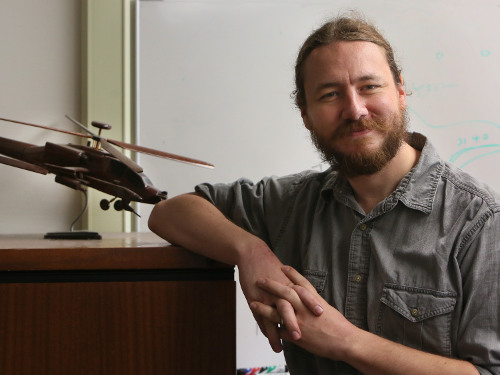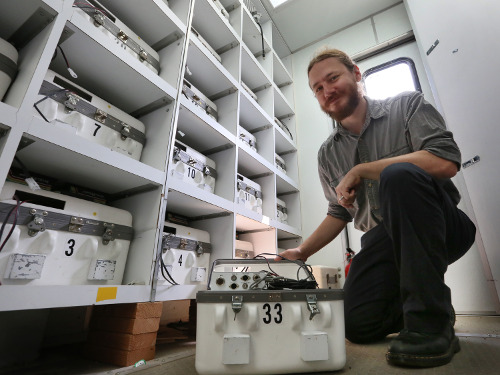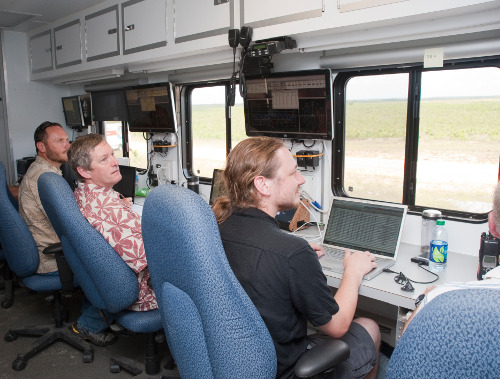 |
| August 18, 2015 | Volume 11 Issue 31 |
Designfax weekly eMagazine
Archives
Partners
Manufacturing Center
Product Spotlight
Modern Applications News
Metalworking Ideas For
Today's Job Shops
Tooling and Production
Strategies for large
metalworking plants
Wings:
NASA researcher develops model that could quiet down noisy helicopters

Eric Greenwood, a research aerospace engineer at NASA Langley. [Credits: NASA/David C. Bowman]
By Joe Atkinson, NASA Langley Research Center
If you live in a relatively well-populated area, you've probably experienced it: the noisy whop-whop-whop of a helicopter flying overhead, adding unwelcome racket to a family dinner or peaceful walk in the park.
It's an occasional, minor nuisance in smaller towns and cities.
But in metropolises like Los Angeles and New York, where news, police, medical, and sightseeing helicopters often clutter the sky, it's become a serious problem.
"People in those communities are becoming so annoyed by the helicopter overflight noise that they're looking into local regulations and restricting the kinds of helicopter operations that can be done in those areas," said Eric Greenwood, a research aerospace engineer at NASA's Langley Research Center in Hampton, VA.
Residents in both those cities (and others -- you can add San Francisco, Las Vegas, Chicago, Washington D.C., and Boston to the list) may be relieved to hear that the NASA Langley researcher is on the case.
Greenwood, who specializes in rotorcraft research, has developed a method he calls Fundamental Rotorcraft Acoustic Modeling for Experiments, or FRAME, that could soon help reduce some of that pesky, problematic helicopter noise.

Greenwood is pictured in one of the center's mobile acoustic labs, where he and other researchers conduct field studies of rotorcraft noise. [Credits: NASA/David C. Bowman]
FRAME works by bringing together two key elements: researchers' basic understanding of the physics of rotorcraft noise and existing noise data from flight tests and wind tunnel measurements.
By tuning that base physics knowledge to the existing test data, Greenwood is able to predict, with accuracy, where noise will become a problem in untested -- or even untestable -- flight scenarios.
"With the conventional modeling that we've been using so far, you really are only able to take the data you collect and replay exactly those same conditions," he said. "[FRAME] lets you generalize noise data you've collected to any other sort of operating conditions."
Greenwood recently presented a paper at the American Helicopter Society International's 71st Annual Forum and Technology Display that compared his FRAME predictions with noise data he and some colleagues collected during helicopter flight tests in 2011 at Eglin Air Force Base in Florida's panhandle.
The flight test data and the FRAME predictions had "very good agreement," according to Greenwood. "We were able to show that the effect of maneuver noise could be as much as a 10-decibel change relative to what happens to a helicopter in steady flight."
To the average human ear, that 10-decibel change would sound twice as loud.

In 2011, Eric Greenwood traveled to Eglin Air Force Base in Florida's panhandle to collect noise data from a series of flight tests of a Bell 430 helicopter. Pictured, from left, are Bell Helicopter's Royce Snider, NASA Langley's Mike Watts, and Greenwood. [Credits: NASA]
The distinctive noise a helicopter makes is the result of a phenomenon called blade-vortex interaction. When a helicopter's rotor blade hits the wake vortex formed by the blade in front of it, it causes that pulsing, whop-whop-whop sound.
With FRAME giving researchers the ability to predict when and where that sound will become an issue, Greenwood believes residents in cities like Los Angeles and New York could be on the verge of getting a little relief from the noise.
"Now that we have a model that works," he said, "our hope for the near future is to be able to use this model to come up with guidance for helicopter pilots and operators as to how they can fly more quietly."
It could be as simple as having a pilot execute a right turn in a way that produces less noise.
"There are different ways you might be able to do that right turn," Greenwood said. "You could accelerate when you go into that turn. You could climb as you turn."
As one might imagine, Greenwood's research has snagged the interest of the military, too. The same flight adjustments that would reduce noise complaints in Las Vegas could help an Army helicopter make a quieter approach into a treacherous battlefield situation.
Whether the application is civilian or military, Greenwood imagines his research could open the door to a future where helicopters have built-in, computerized guidance controls.
"Imagine if I had a helicopter where if I'm about to go into a noisy place, the stick forces get a little stronger," he said. "I'm still the pilot in command. I can do whatever I want, but it's giving me a subtle nudge toward a quieter direction."
It's a future a noise-weary New Yorker would probably love to see come to fruition.
Published August 2015
Rate this article
View our terms of use and privacy policy
